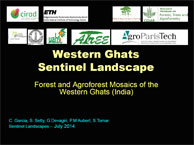Agroforestry systems (coffee, tea, rubber, pepper, arecanut, cardamom) shape much of Western Ghats in India. Commercial agriculture in this area has existed for centuries. Now, these commercial crops reach the margins of protected areas. In many cases, the only forests left are small sections which are either community-managed (i.e. sacred forests) or privately owned.
We propose an Sentinel Landscape located in the central section of the mountain range, from Goa to the Palakkad Gap, spanning across Karnataka, Kerala and Tamil Nadu. All the ecosystem services in the intended areas express different spatial scales in different landscape contexts. Understanding the dynamics between tree cover, biodiversity and the variety of ecosystem services is a predominant issue in such landscapes.
One major undertaking will be to include 'dis-services' in the equation. We cannot fully understand the relationship between people and forests without incorporating what the costs of living in close proximity to forest entails: crop loss to wildlife, transmission of diseases, insecurity, etc. Resolving economic and environmental trade-offs is similarly important, and a scientifically and politically informed framework to understand the trade-offs between services and between stakeholders, and the imbalance between actors can help define the outcomes of proposed policies of natural resources management.
Western Ghats Sites
Kodagu
- Forests, agroforestry and rice cultivation equally represented in the landscape.
- Complex, shade grown coffee agroforestry systems
- Small holdings (<2 ha) represent 58% of the holdings and 22% of the coffee area.
- Complex tenure system with over 39 land rights
- Human density 135 hab/km², Tribal population 8,41%
- Female literacy rate: 72,26%
Chamarajanagar
- Area of interest: Biligirirangana Temple (BRT) Hills
- Land sparing scenario: 52% of the area under protected area (including Tiger Reserves).
- Soliga tribal settlements claiming rights over forest land and forest ressources.
- Density 200 hab/km², Tribal population 11%
- Female literacy rate: 42,48 %
Wayanad
- Highest human density: 380 hab/km²,
- Tribal population: 17,43%
- Female literacy rate: 80,72 %
- Landscape Mosaic with cash crops-based agroforestry systems: pepper, cardamom, coffee & tea.
- High proportion of Teak plantations in State controlled forests
Nilgiris
- Population density: 300 hab/km²
- Tribal communities including Toda, Badaga, Kota, Irular and Kurumbas – 3,72% of the population
- Female literacy rate: 71,64
- Range of mountains with at least 24 peaks above 2,000 metres.
- Tea-dominated landscape, and diverse horticultural systems
WGSL Baseline
Village selection
- Initial listing of villages with census data – 2011
- Visit to Panchayat Offices, knowledge of partners
- Location of villages within or near the site
- Criteria for selection: Caste and Tribe composition
LDSF progress
- Site name: Madikeri (Kodagu district)
- No. of Clusters: 16 (16 Completed)
- Sample plots: 160 (160 Completed)
- Total samples collected: Top: 160, Sub: 160, CM: 160










